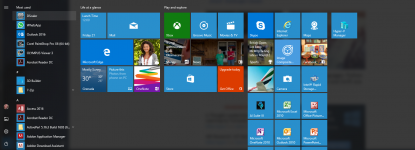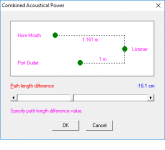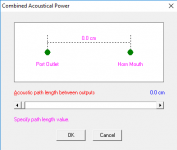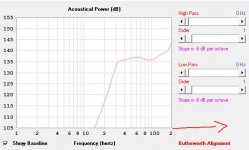Hmm... where can I download a copy of this TL.app? I might want to have a look at it...
Yeah, the size requirements of said stubs is what worries me. The DTS10 is tuned almost a good octave below the TH designs I'm looking at though (which would also lower the out of band resonance frequencies too), and the stubs should decrease in length as target frequency increases.
It looks like the length of the stub will need to be about 1/4 wavelength of the resonance that needs to be damped. For my PO3 design, the first major resonance peak is at 160 Hz, so that suggests that the stub will need to be around 340*100/(160*4)=53.1 cm or just under 21". That should be easy to fit on many of the POC's panels, including the front panel. Heck, I could just drill a hole right above the mouth and attach a pipe of that length right there to act as the stub resonator. However, the question is of course what the CSA of the stub needs to be in order to damp the resonance at that frequency enough to bring down to passband level. There's also the question of what impact on the rest of the horn's passband would this have.
I think I'm going to fiddle with Akabak a bit to see what the results look like. JAG, if you want to have a go at it, the parameters for the POC3 design are available at the link below:
The Subwoofer DIY Page v1.1 - Projects : "Proof of Concept #3"
Having the right options etc within a program to evaluate/sim stubs, is essential in my opinion. So if HR can include such functions =
I have nothing against making the simulator more fully functioning but I'm not sure I agree with this sentiment.
Stubs are not really all that effective - if they were Danley wouldn't have also used stuffing AND extra inductance in the DTS-10 to calm the spikes. And he would have continued to use stubs in later designs but he didn't, he stopped using them after that one single model.
I'm not a fan of the concept at all - using up a good bit of box space to cancel out problems. A bit of stuffing in the throat area from the closed end to a bit past the driver is about as far as I'm personally willing to go to calm resonances. If that's not enough I'd be thinking redesign or a different type of alignment, not stubs.
JAG, if you want to have a go at it, the parameters for the POC3 design are available at the link below:
Absolutely, I'd love to do a stub study.
But I don't have my Akabak computer at the moment (I could go get it at anytime though) and I'm completely swamped. I've got my job, which isn't supposed to extend this far into the year (I'm usually mostly free for a few months in the summer but not this year) and I just got a mini dsp and a Umik that I'm trying to set up. There's a bit of a time crunch on the dsp and mic setup too, I convinced a buddy to order a mini dsp as well so we could both save on shipping. In exchange I told him I'd do a fresh install of Windows (it's XP so that's not so easy anymore what with finding drivers and the general issues with an outdated OS), set up the mini dsp, measure his room, make auto eq filters with REW, load the filters into the mini dsp, teach him how to use the computer and dsp and manually set it all up for him.
I put in about 12 hours beating the XP computer into submission, installing windows, finding drivers, installing programs. This used to be a 2 hour job but not anymore, not after XP has been obsoleted. All the dsp and Umik stuff is new to me so I'm reading manuals and slowly working through it all.
But yeah, I'd love to do a small stub study if you have time to wait until I get a bit of free time. What I'm expecting is that I'll just prove they are a waste of space and not very effective. But even if that is the result it will still be time well spent. I like to do a research project every year or two and I haven't done anything since the lossy inductance study. That's a while ago now.
I put in about 12 hours beating the XP computer into submission, installing windows, finding drivers, installing programs.
Hah, do like me and just use a VM
one of my designs has a front radiating driver and a horn opening at the back. How do you specify that? "Around" the box or direct distance as if, no box was there?
Hi Kurt,
An excellent question - I need to improve the explanation in the Help file
Kind regards,
David
A request for a new feature: The ability to model the effect of a resonant "stub", preferably at any point in the horn, but can be restricted to S2, S3 and S4 as necessary.
Hi Brian,
It's not going to happen - would require too much work
Kind regards,
David
I'm not a fan of the concept at all - using up a good bit of box space to cancel out problems. A bit of stuffing in the throat area from the closed end to a bit past the driver is about as far as I'm personally willing to go to calm resonances. If that's not enough I'd be thinking redesign or a different type of alignment, not stubs.
Agree 100%.
Hah, do like me and just use a VM. I've just set up a WinXP VM under Hyper-V on my Windows 10 PC. Now on to download and install Akabak...
Been there, done that, got the t shirt. I actually tried it twice. I used Oracle VM on a fresh install of Windows on my laptop with i7 processor and 8 Gb ram. The laptop ran so hot it was roasting my lap. This laptop never runs hot, not even with 30 or more google Chrome tabs open and a dozen apps running but when I put the VM on it all hell broke loose.
IIRC I also installed Sketchup at the same time so I'm not 100 percent sure which program caused the issue but my 10 year old netbook runs Akabak and Sketchup with no problems at all so I really don't want either of those things on my good laptop.
I just have to get my netbook back and find some time and I can do some sims.
Is this your first time using Akabak? If so, this is how I learned.
AkAbak for Dummies
That's a fantastic resource, it's all I've needed to learn Akabak. Within 2 hours I was reading scripts, sketching out the enclosure from the scripts I read, writing my own scripts and doing some simple sims.
I STRONGLY recommend doing all you can with Hornresp first, then export the file, import it into Akabak and add whatever is missing. Let Hornresp do the hard work for you. Adding a stub to an already complete tapped horn is easy, scripting the whole thing in Akabak is not so easy.
Been there, done that, got the t shirt. I actually tried it twice. I used Oracle VM on a fresh install of Windows on my laptop with i7 processor and 8 Gb ram. The laptop ran so hot it was roasting my lap. This laptop never runs hot, not even with 30 or more google Chrome tabs open and a dozen apps running but when I put the VM on it all hell broke loose.
Why not use Windows' built-in Hyper-V feature? Works fine on my PC, with no issues about excessive power use. I use it to host 2 or three VMs on my home PC, and about six VMs on my office PC, with guest OS' ranging from Linux to Windows 2012 R2 server.
And you can always pause the VM when you're not using it
As for Akabak, I did as you said and just exported the HornResp sim as an Akabak script and used that. I'm not sure that I added the stub properly, so I'm going to review what I did tonight...
I never heard of hyper-v so I just looked it up. For Win 7 it sounds pretty complicated - Running Hyper-V on Windows 7!
I think I'll just use my netbook.
EDIT - since it will probably be mentioned, I have no desire to upgrade to Win 10.
I think I'll just use my netbook.
EDIT - since it will probably be mentioned, I have no desire to upgrade to Win 10.
I never heard of hyper-v so I just looked it up. For Win 7 it sounds pretty complicated - Running Hyper-V on Windows 7!
I think I'll just use my netbook.
No wonder - trying to run Hyper-V under Win7 is a bit like trying to retrofit a VW bus with a hybrid engine.
Hyper-V is a component of Win8 (Pro and up) and Win10 (Pro and up). I take it that you didn't take advantage of the free upgrade..?
I absolutely did not upgrade - I've only played with Win 10 for a few minutes but I prefer Win 7, it seems to run faster and I've heard things about the lack of privacy on Win 10. Starting with Win 8 things went in the wrong direction IMO. Catering to the mobile devices was a huge mistake and a detriment to the actual computer users. I don't like the mobile touch screen type interface at all, it looks dumb and doesn't provide any advantages for computer users. I spent 5 minutes with Win 8 when it came out and I wanted to throw the computer out the window.
The upgrade is still available and still free but I'm not interested, at least not at this point. I'm sure Microsoft will obsolete Win 7 asap so some day soon I'll be forced to upgrade but I'm going to hold out for as long as possible until someone gives me a really good reason not to. Hyper-V isn't going to do it when I have a netbook that works fine.
The upgrade is still available and still free but I'm not interested, at least not at this point. I'm sure Microsoft will obsolete Win 7 asap so some day soon I'll be forced to upgrade but I'm going to hold out for as long as possible until someone gives me a really good reason not to. Hyper-V isn't going to do it when I have a netbook that works fine.
Stubs are not really all that effective - if they were Danley wouldn't have also used stuffing AND extra inductance in the DTS-10 to calm the spikes. And he would have continued to use stubs in later designs but he didn't, he stopped using them after that one single model.
There are no stubs in a DTS-10.
I believe you guys are thinking of the DTS-20.
My S&B thread Stubs & Buts !
Well i was thinking, that if someone wanted to evaluate/sim stubs, then having the right options etc to do so would be welcome. Of course, if people don't want to use stubs, then they won't require it.
Then you'll need to sim them etc Looking forward to that
Looking forward to that 
And that's a Very BIG understatement ! See here for starters Stop Your PC updating to W10 & Windows 7 & 8 App to Block W10 Update & GRC | Never10
Not just W10 Windows 7/8/8.1 can Spy on you too !
Yep, & i don't need All that crap either. I'm still on XP/SP2 but Very securely etc set up
but Very securely etc set up 
Originally Posted by just a guy
Originally Posted by Zero D
Having the right options etc within a program to evaluate/sim stubs, is essential in my opinion. So if HR can include such functions =
I have nothing against making the simulator more fully functioning but I'm not sure I agree with this sentiment.
Well i was thinking, that if someone wanted to evaluate/sim stubs, then having the right options etc to do so would be welcome. Of course, if people don't want to use stubs, then they won't require it.
Absolutely, I'd love to do a stub study.
Then you'll need to sim them etc
I've heard things about the lack of privacy on Win 10.
And that's a Very BIG understatement ! See here for starters Stop Your PC updating to W10 & Windows 7 & 8 App to Block W10 Update & GRC | Never10
Not just W10 Windows 7/8/8.1 can Spy on you too !
Starting with Win 8 things went in the wrong direction IMO. Catering to the mobile devices was a huge mistake and a detriment to the actual computer users. I don't like the mobile touch screen type interface at all, it looks dumb and doesn't provide any advantages for computer users
Yep, & i don't need All that crap either. I'm still on XP/SP2
I absolutely did not upgrade - I've only played with Win 10 for a few minutes but I prefer Win 7, it seems to run faster and I've heard things about the lack of privacy on Win 10. Starting with Win 8 things went in the wrong direction IMO. Catering to the mobile devices was a huge mistake and a detriment to the actual computer users. I don't like the mobile touch screen type interface at all, it looks dumb and doesn't provide any advantages for computer users. I spent 5 minutes with Win 8 when it came out and I wanted to throw the computer out the window.
OK, this thread is about HornResp, not Windows, so this will be my first and last post on the latter. I've attached a picture of what I see when I click on the "Window" icon at the bottom left hand corner of my screen - basically the same thing you do when bringing up the menu in Windows 7. Windows 10 automatically adds my most-used application list on the left so I don't have to go menu-diving or otherwise to open them. I can get to anything I regularly use easily and quickly.
As for performance, I haven't noticed any performance hits since moving to Windows 10 on most of my PCs (I did almost all of them the same day). Well, maybe on my old netbook with its 1GB of RAM. Evidently Win10's spec now says it requires 2GB minimum...
Attachments
The new features around allowing filters to be used on the main screen are very welcome so thanks for implementing them.
One usability issue, or a bug, is that switching the output (horn/direct radiator/combined) selected on the acoustical power screen resets the filter state. This means you have to keep turning the filter back on when flipping between output views.
One usability issue, or a bug, is that switching the output (horn/direct radiator/combined) selected on the acoustical power screen resets the filter state. This means you have to keep turning the filter back on when flipping between output views.
One usability issue, or a bug, is that switching the output (horn/direct radiator/combined) selected on the acoustical power screen resets the filter state. This means you have to keep turning the filter back on when flipping between output views.
Hi 3ll3d00d,
Thanks for the feedback. It's not a bug, but I agree that it would be better if the filter could stay on when the output view is changed. I will see what can be done about it.
Kind regards,
David
- Home
- Loudspeakers
- Subwoofers
- Hornresp



